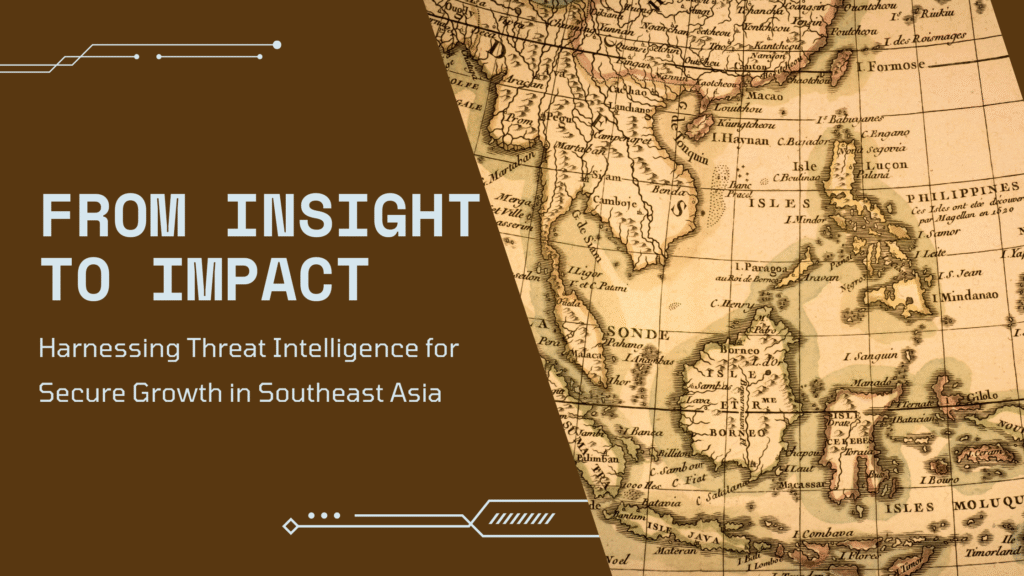Southeast Asia faces an unprecedented surge in cyber threats as the region’s digital economy rapidly expands toward $1 trillion by 2030. Organizations across ASEAN countries must urgently implement robust cybersecurity frameworks to protect critical infrastructure, financial systems, and sensitive data from sophisticated threat actors. This comprehensive analysis reveals alarming trends, provides actionable recommendations, and presents strategic investment opportunities to fortify the region’s cyber resilience.
The cybersecurity landscape in Southeast Asia has reached a critical inflection point in 2024. With 400 ransomware attacks targeting regional businesses daily and cyber incidents affecting 78% of organizations, the region confronts an escalating threat environment that demands immediate action. Indonesia leads with 3.3 million total cyber attacks, followed by Vietnam with 2.98 million incidents, highlighting the widespread nature of these threats across the digital ecosystem.
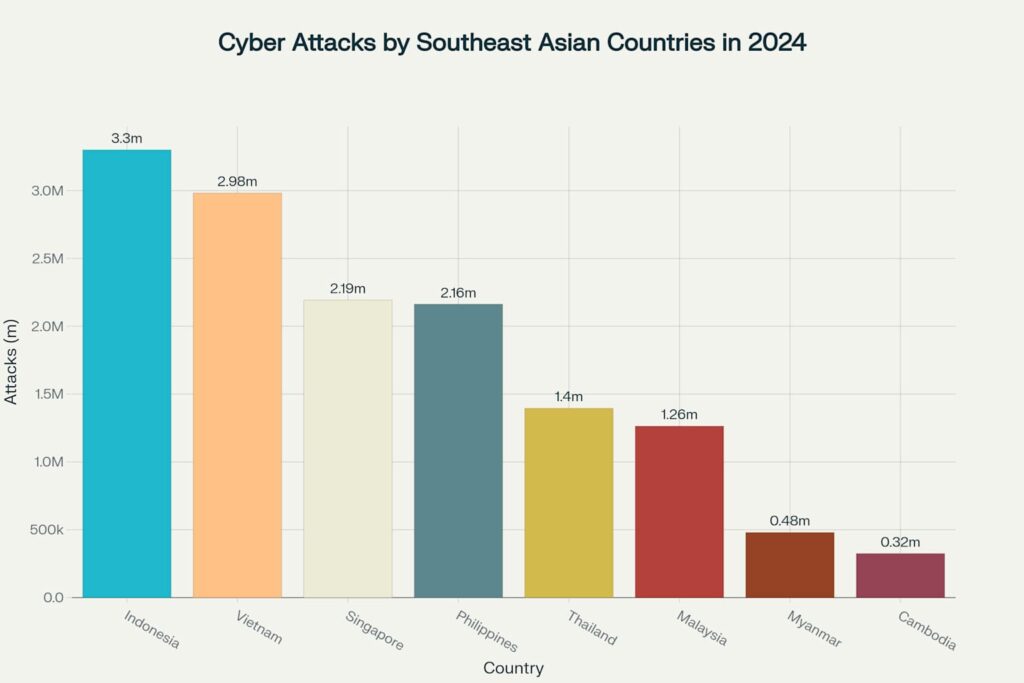
Total cyber attacks experienced by Southeast Asian countries in 2024, with Indonesia facing the highest number of incidents
Regional Cyber Threat Landscape Overview
Attack Volume and Distribution
Southeast Asia’s cyber threat environment has evolved into a complex, multi-vector challenge affecting all sectors of the digital economy. Malware attacks dominate the threat landscape at 41.2% of all incidents, while phishing campaigns account for 19.9% of total attacks. The sophistication and frequency of these attacks have grown exponentially, with organizations experiencing a 237% increase in ransomware incidents compared to previous years.
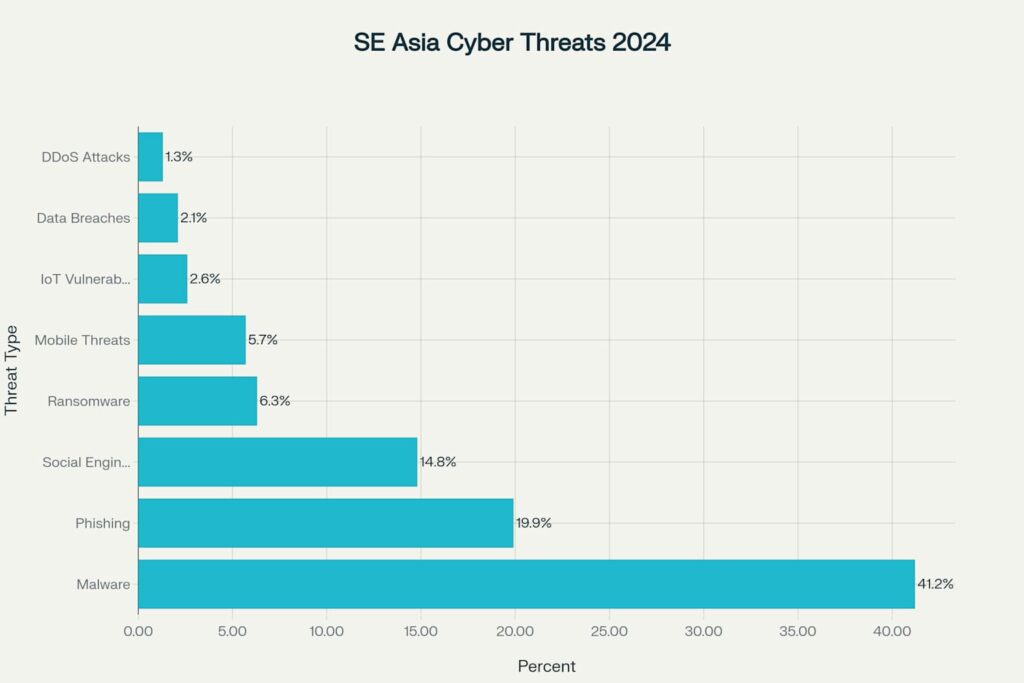
Breakdown of cyber threat types affecting Southeast Asia in 2024, showing malware and phishing as the dominant attack vectors
The financial impact has been equally devastating. Economic losses from cyber incidents reached $9.8 billion in 2024, representing a 58% increase from the previous year. Data breaches specifically cost organizations an average of $3.05 million per incident in Southeast Asia, with recovery times extending beyond traditional expectations.
Country-Specific Threat Analysis
Indonesia emerges as the most targeted nation, facing 57,554 ransomware attacks alongside millions of phishing attempts. Vietnam follows with 29,282 ransomware incidents, while the Philippines recorded 21,629 attacks. These statistics reflect not only the region’s growing digital footprint but also the increasing sophistication of threat actors targeting ASEAN economies.
Singapore, despite having robust cybersecurity infrastructure, still faced 208 ransomware attacks and experienced a 174% surge in phishing attempts between 2021 and 2022. This demonstrates that even the most prepared nations remain vulnerable to evolving cyber threats.
Industry Sector Vulnerability Analysis
Financial services bear the heaviest burden of cyber attacks, representing 16.7% of all incidents with 45,600 attacks recorded in 2024. Government institutions follow closely at 14.2% with 38,900 attacks, while healthcare organizations face 11.7% of total incidents. These sectors typically experience longer recovery times, with energy and utilities requiring an average of 89 days to fully restore operations after an incident.
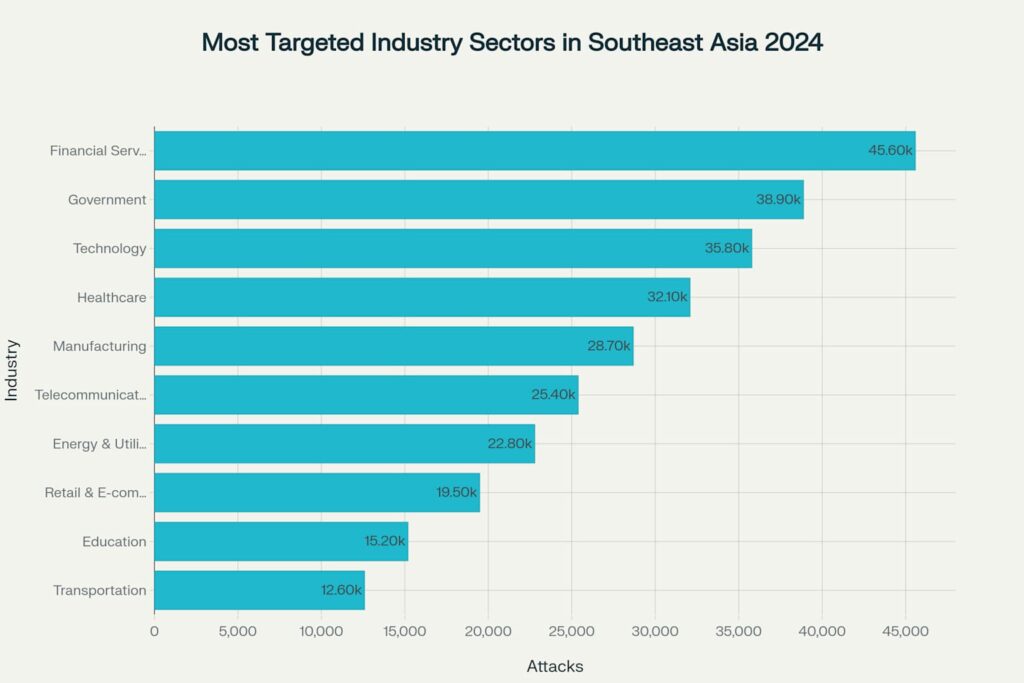
Industry sectors most frequently targeted by cyber attacks in Southeast Asia during 2024, with financial services leading as the primary target
The concentration of attacks on critical infrastructure sectors poses significant risks to national security and economic stability. Manufacturing, telecommunications, and transportation sectors also face substantial threats, with attack frequencies ranging from 12,600 to 28,700 incidents annually.
Emerging Threat Vectors
The integration of artificial intelligence and machine learning technologies has introduced new vulnerability categories. IoT vulnerabilities now account for 2.6% of total threats, while mobile threats have surged to 5.7% of all incidents. These emerging attack vectors require specialized defensive strategies and updated security frameworks.
The Southeast Asian cybersecurity market is experiencing unprecedented growth, valued at USD 4.37 billion in 2024 and projected to reach USD 7.07 billion by 2029, representing a compound annual growth rate of 17.77%. This expansion reflects both the urgent need for enhanced security measures and the region’s commitment to digital resilience.
Organizations are prioritizing cloud-based security solutions, which dominate spending patterns due to their scalability and cost-effectiveness. Malaysia alone has committed over RM1.8 billion under its Cyber Security Strategy 2020-2024, while Singapore’s cybersecurity market is expected to reach USD 608.24 million in network security alone by 2025.
The enterprise security market shows particularly strong growth potential, with SMBs and midmarket companies comprising 46% of regional spending. Their cybersecurity expenditure is projected to exceed USD 12 billion by 2027, indicating substantial opportunities for security service providers.
Cybersecurity Trends and Evolution
The cyber threat environment has undergone a dramatic transformation over the past five years. Total incidents have increased from 45.2 million in 2020 to 215.8 million in 2024, representing a 377% increase. This exponential growth coincides with rapid digital transformation across ASEAN economies.
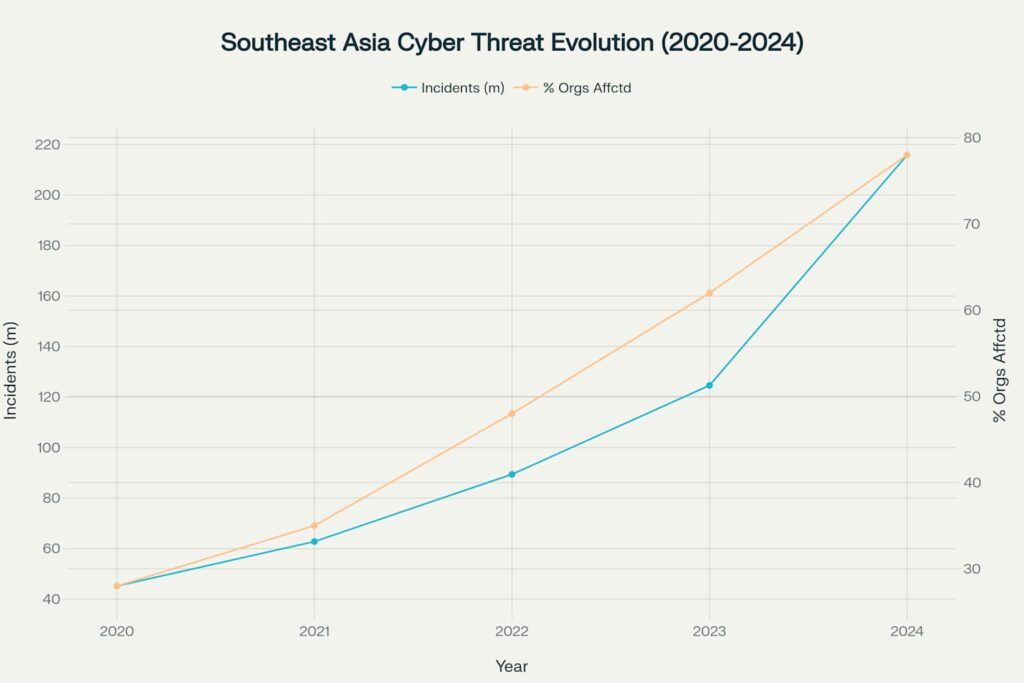
Evolution of cyber threats in Southeast Asia from 2020-2024, showing dramatic increases in both incident volume and organizational impact
Emerging Attack Methodologies
Cybercriminals increasingly leverage artificial intelligence and machine learning to enhance attack sophistication. AI-driven attacks now constitute a significant portion of the threat landscape, with attackers using automated tools to identify vulnerabilities and launch targeted campaigns. Supply chain attacks have also emerged as a critical concern, exploiting trusted software relationships to subvert entire cybersecurity postures.
Regional Policy Frameworks and Initiatives
ASEAN Cybersecurity Cooperation
ASEAN has implemented comprehensive cybersecurity cooperation strategies, including the establishment of the ASEAN Regional Computer Emergency Response Team (CERT) with headquarters in Singapore. Malaysia leads as the first overall coordinator, facilitating information sharing and collaborative incident response across member states.
The ASEAN Cybersecurity Cooperation Strategy 2021-2025 focuses on advancing cyber readiness through enhanced CERT-CERT cooperation, capacity building, and coordinated regional cybersecurity initiatives. This framework emphasizes the importance of collective resilience against increasingly sophisticated transboundary cyberattacks.
National Cybersecurity Initiatives
Individual ASEAN countries have developed robust national cybersecurity frameworks. Malaysia’s Cyber Security Act 2024 mandates comprehensive protection for eleven National Critical Information Infrastructure sectors, including banking, energy, healthcare, and telecommunications. Singapore’s Cybersecurity Strategy 2021 prioritizes critical infrastructure protection, workforce capability development, and international cooperation.
Thailand’s Cybersecurity Act provides legal structure for national defense and enables deeper public-private coordination under the Thailand 4.0 program. These national initiatives create opportunities for international cybersecurity vendors to provide specialized expertise and support digital transformation goals.
Technical Mitigation Strategies
Comprehensive Security Framework Implementation
Organizations must adopt multi-layered security architectures incorporating endpoint detection and response (EDR), security information and event management (SIEM), and security orchestration, automation, and response (SOAR) platforms. Zero-trust security models have proven particularly effective, with ASEAN nations increasingly implementing these frameworks to secure hybrid cloud environments.
Artificial intelligence and machine learning-powered threat detection systems can significantly enhance security postures. Vietnam’s AI-based threat monitoring system successfully thwarted thousands of phishing attempts targeting online banking users in 2023. Real-time threat intelligence sharing among regional partners has proven crucial for early warning systems and coordinated response efforts.
Energy, telecommunications, and financial sectors require specialized security frameworks addressing Industrial Control Systems (ICS) and Supervisory Control and Data Acquisition (SCADA) vulnerabilities. The implementation of ICS-specific security protocols and network segmentation strategies can significantly reduce attack surfaces and limit potential damage from successful breaches.
Investment Opportunities and Strategic Recommendations
The Southeast Asian cybersecurity market presents substantial investment opportunities across multiple domains. Managed Security Services (MSS) represent the fastest-growing segment, with Security Services projected to reach USD 2.37 billion in 2024. Cloud security solutions continue expanding as organizations migrate to hybrid infrastructure models.
Cybersecurity training and awareness programs constitute another high-growth opportunity, with regional governments and enterprises recognizing the critical importance of human factor security. Threat intelligence platforms and incident response services also show strong demand as organizations seek to enhance their defensive capabilities.
Strategic Investment Areas
- AI-powered Security Analytics: Machine learning-based threat detection and automated response systems
- Cloud Security Platforms: Comprehensive solutions for hybrid and multi-cloud environments
- Critical Infrastructure Protection: Specialized ICS/SCADA security frameworks
- Managed Detection and Response (MDR): 24/7 monitoring and incident response services
- Cybersecurity Training Platforms: Interactive education and simulation environments
As organizations across Southeast Asia strengthen their cybersecurity postures, Bluefire RedTeam’s comprehensive offensive security services provide critical capabilities for proactive threat identification and defensive enhancement. Our specialized expertise in red team assessments, penetration testing, and vulnerability management directly addresses the sophisticated threat landscape facing ASEAN economies.
Bluefire Red Team’s offensive security approach simulates real-world cyberattacks to identify vulnerabilities before malicious actors can exploit them. Our comprehensive security assessments help organizations understand their actual risk exposure and develop effective mitigation strategies tailored to Southeast Asian threat environments.
The company’s continuous vulnerability assessment and penetration testing services provide ongoing security validation, essential for organizations operating in the dynamic threat landscape documented throughout this report. Our managed security services offer 24/7 monitoring and response capabilities, addressing the critical need for continuous threat detection identified across the region.
Given the high concentration of attacks on financial services, government, and healthcare sectors, Bluefire Red Team’s industry-specific security assessments provide targeted protection for critical infrastructure. Our compliance-focused security evaluations help organizations meet regulatory requirements while maintaining operational efficiency.
Bluefire Redteam’s cybersecurity training and simulation services address the human factor vulnerabilities that contribute to successful social engineering and phishing attacks. These programs are particularly valuable given the 155% growth in social engineering attacks documented across Southeast Asia.
The cybersecurity challenges facing Southeast Asia require immediate, comprehensive action from government leaders, business executives, and security professionals. Bluefire Red Team’s proven expertise in offensive security provides organizations with the proactive capabilities needed to stay ahead of evolving threats.
Schedule a comprehensive security assessment with Bluefire RedTeam to:
- Identify critical vulnerabilities before attackers exploit them
- Validate existing security controls against real-world attack scenarios
- Develop targeted remediation strategies for your specific threat environment
- Enhance incident response capabilities through realistic simulation exercises
- Achieve compliance with regional cybersecurity regulations and standards
Contact Bluefire Red Team today to begin strengthening your organization’s cyber resilience.
In an environment where 400 daily ransomware attacks target Southeast Asian businesses, proactive security assessment is not optional—it’s essential for survival in the digital economy. Bluefire Red Team’s comprehensive offensive security services provide the strategic advantage organizations need to protect their most valuable assets and maintain operational continuity in an increasingly hostile cyber environment.
Conclusion
Southeast Asia stands at a critical juncture in its cybersecurity evolution. With cyber threats growing in both volume and sophistication, the region must urgently implement comprehensive defensive strategies, enhance international cooperation, and significantly increase cybersecurity investments. The projected growth of the digital economy to over $1 trillion by 2030 makes robust cybersecurity frameworks essential for sustainable economic development.
The data presented demonstrates that while challenges are substantial, the region possesses the economic resources, technological capabilities, and collaborative frameworks necessary to build effective cyber resilience. Success will require sustained commitment from government leaders, private sector executives, and international partners working together to create a secure digital future for Southeast Asia’s 685 million citizens.
Through strategic investments in advanced security technologies, comprehensive workforce development, and enhanced regional cooperation, ASEAN can transform its cybersecurity challenges into competitive advantages, establishing the region as a global leader in digital trust and cyber resilience.


